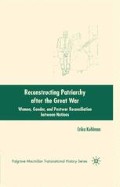Abstract
The writer Ernest Hemingway wrote the definitive American Great War novel, A Farewell to Arms, after his own experience as an ambulance driver on the Italian front. In the story, mechanics with an army medical unit sit in a dugout and debate how and whether the combatants—rather than their political leaders—should stop the war, as the company awaits the start of an expected bombing campaign. The men, including the Italians Passini and Manera, and the American ambulance driver Lieutenant Frederic Henry, smoke quietly and drink rum together. Soon, the discussion turns to the various provincial Italian units—the Piedmont bersaglieri and the Nepalese granatieri—and which group would more likely attack than the others; male honor is clearly at stake. Soldiers refusing to attack were executed by the carabinieri (military police), reports Passini. But if not for such punishment, counters Manera, no one would attack. If no one attacked, he continues, the war would be over. Frederic Henry adds that the war would not end if one side stopped fighting, and that conditions could be worse if soldiers laid down their arms.
Access this chapter
Tax calculation will be finalised at checkout
Purchases are for personal use only
Preview
Unable to display preview. Download preview PDF.
Notes
Ernest Hemingway, A Farewell to Arms (New York: Charles Scribner’s Sons, 1929; repr. 1993), 49–50.
Paul Fussell, The Great War and Modern Memory (New York: Oxford University Press, 1975), 21–22, provides a list of feudal words and phrases in use by the British during the war; Stefan Goebel, The Great War and Medieval Memory: War, Remembrance and Medievalism in Britain and Germany, 1914–1940 (Cambridge: Cambridge University Press, 2007), compares medievalism in Great Britain and Germany.
Kenneth S. Zagacki, “Rhetoric, Redemption, and Reconciliation: a Study of Twentieth Century Postwar Rhetoric,” PhD diss. (University of Texas at Austin, 1986), 5.
David M. Kennedy, Over Here: The First World War and American Society (New York: Oxford University Press, 1980), 229; Susanne Rouette, Sozialpolitik als Geschlechterpolitik: Die Regulierung der Frauenarbeit nach dem Ersten Weltkrieg (Frankfurt: Campus, 1993), 7–8; Jeffrey S. Reznick offers the same argument about Britain in Healing the Nation: Soldiers and the Culture of Care-giving inBritain During the Great War (Manchester: Manchester University Press, 2004), 9; Henry F. May, The End of American Innocence: A Study of the First Years of Our Own Time, 1912–1917 (New York: Alfred A. Knopf. 1959), 393–97.
Sheila Meintjes, Anu Pillay, and Meredeth Turshen, “There is No Aftermath for Women,” in The Aftermath: Women in Post-Conflict Transformation, ed. Meintjes, Pillay, and Turshen (London: Zed Books, 2002), 4.
Keith L. Nelson, Victors Divided: America and the Allies in Germany, 1918–1923 (Berkeley: University of California Press, 1975).
Sally Marks, The Illusion of Peace: International Relations in Europe, 1918–1933 (New York: St. Martin’s, 1976; repr. Basingstoke: Palgrave Macmillan, 2003); Klaus Schwabe, Woodrow Wilson, Revolutionary Germany, and Peacemaking, 1918–1919: Missionary Diplomacy and the Realities of Power, trans. Rita Kimber and Robert Kimber (Chapel Hill: University of North Carolina Press, 1985).
Norman Rich, The Age of Nationalism and Reform, 1850–1890, 2nd ed. (New York: W. W. Norton, 1977), xiv, 101–44.
Shelley Anderson, “Women’s Many Roles in Reconciliation,” in People Building Peace: 35 Inspiring Stories from Around the World, ed. European Centre for Conflict Prevention (Maastricht: European Centre for Conflict Prevention, 1999), 230–36.
Maurice Rickards, Posters of the First World War (New York: Walker, 1968), 114–35.
Rafael Scheck, “Women against Versailles: Maternalism and Nationalism of Female Bourgeois Politicians in the Early Weimar Republic,” German Studies Review 22, no. 1 (February 1999): 21–22.
Jane Addams, Peace and Bread in Time of War, ed. Blance Wiesen Cook (New York: Garland, 1972). 208; Alice Hamilton and Jane Addams, “After the Lean Years: Impressions of Food Conditions in Germany When Peace was Signed,” Survey (September 6, 1919): 793–97.
Karen Hagemann, “Home/Front: The Military, Violence and Gender Relations in the Age of the World Wars,” in Home/Front: The Military, War and Gender in Twentieth-Century Germany, ed. Hagemann and Stefanie Schüler-Springorum (London: Berg, 2002), 2, analyzes the ways in which the traditional categories of “home” and “front” perpetuated the privileging of male soldiers and the marginalization of women; chapter 1 of the present volume addresses the categories of “victor” and “vanquished,” and specifically the U.S.’s placement within those categories (Germany’s placement is discussed in chapters 3 and 5); for histories that do not question the victor-vanquished binary, see Arno J. Mayer, Politics and Diplomacy of Peacemaking: Containment and Counterrevolution at Versailles, 1918–1919 (New York: Knopf, 1967), in which the author discusses the victors and the armistice (53–89), and the vanquished and the armistice (90–116); and Paul Kecskemeti, Strategic Surrender: The Politics of Victory and Defeat (New York: Atheneum, 1964).
Eric J. Hobsbawm, Nations and Nationalism Since 1780: Programme, Myth, Reality (New York: Cambridge University Press, 1992), 131.
Jay Winter, Remembering War: The Great War Between Memory and History in the Twentieth Century (New Haven, CT: Yale University Press, 2006), 136; Winter himself borrows the term from Carol Gluck.
Copyright information
© 2008 Erika Kuhlman
About this chapter
Cite this chapter
Kuhlman, E. (2008). Introduction. In: Reconstructing Patriarchy after the Great War. The Palgrave Macmillan Series in Transnational History. Palgrave Macmillan, New York. https://doi.org/10.1057/9780230612761_1
Download citation
DOI: https://doi.org/10.1057/9780230612761_1
Publisher Name: Palgrave Macmillan, New York
Print ISBN: 978-1-349-37117-4
Online ISBN: 978-0-230-61276-1
eBook Packages: Palgrave History CollectionHistory (R0)

